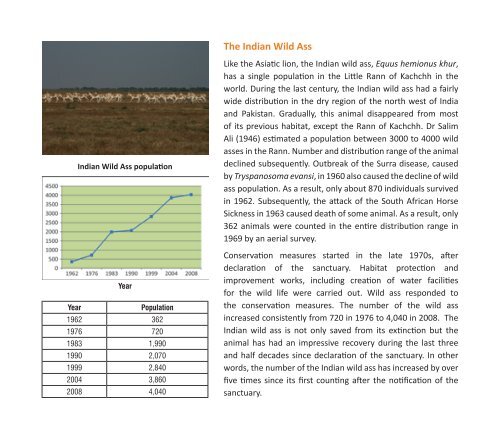Download - Gujarat Biodiversity Board - GSBB
Download - Gujarat Biodiversity Board - GSBB
Download - Gujarat Biodiversity Board - GSBB
You also want an ePaper? Increase the reach of your titles
YUMPU automatically turns print PDFs into web optimized ePapers that Google loves.
Indian Wild Ass population<br />
Year<br />
Year Population<br />
1962 362<br />
1976 720<br />
1983 1,990<br />
1990 2,070<br />
1999 2,840<br />
2004 3,860<br />
2008 4,040<br />
The Indian Wild Ass<br />
Like the Asiatic lion, the Indian wild ass, Equus hemionus khur,<br />
has a single population in the Little Rann of Kachchh in the<br />
world. During the last century, the Indian wild ass had a fairly<br />
wide distribution in the dry region of the north west of India<br />
and Pakistan. Gradually, this animal disappeared from most<br />
of its previous habitat, except the Rann of Kachchh. Dr Salim<br />
Ali (1946) estimated a population between 3000 to 4000 wild<br />
asses in the Rann. Number and distribution range of the animal<br />
declined subsequently. Outbreak of the Surra disease, caused<br />
by Tryspanosoma evansi, in 1960 also caused the decline of wild<br />
ass population. As a result, only about 870 individuals survived<br />
in 1962. Subsequently, the attack of the South African Horse<br />
Sickness in 1963 caused death of some animal. As a result, only<br />
362 animals were counted in the entire distribution range in<br />
1969 by an aerial survey.<br />
Conservation measures started in the late 1970s, after<br />
declaration of the sanctuary. Habitat protection and<br />
improvement works, including creation of water facilities<br />
for the wild life were carried out. Wild ass responded to<br />
the conservation measures. The number of the wild ass<br />
increased consistently from 720 in 1976 to 4,040 in 2008. The<br />
Indian wild ass is not only saved from its extinction but the<br />
animal has had an impressive recovery during the last three<br />
and half decades since declaration of the sanctuary. In other<br />
words, the number of the Indian wild ass has increased by over<br />
five times since its first counting after the notification of the<br />
sanctuary.


